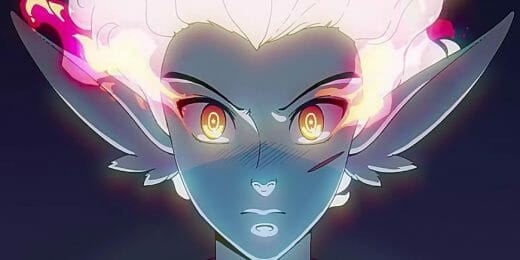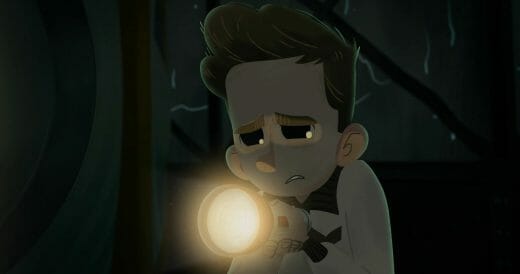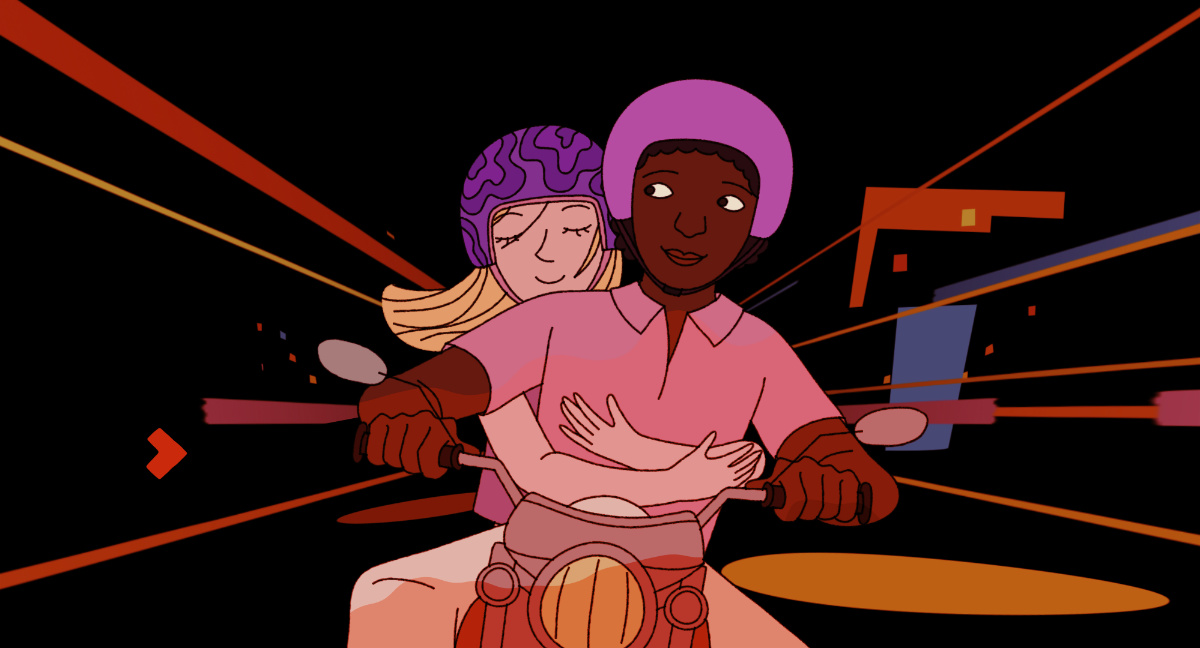
Maybe Elephants is a short animated film that tells the story of three rebellious teenage daughters, a restless mother, and a father struggling with potatoes, who together find themselves living in Nairobi, Kenya. Created by Oscar-winning animator Torill Kove, Maybe Elephants is an homage to family, adolescence, and the power of memories, even when they are unreliable.
Co-produced by Mikrofilm and the National Film Board of Canada, Maybe Elephants serves as sequel of a sort to Torill’s film Me and My Moulton, which also had autobiographical elements. Torill Kove is a Norwegian-born filmmaker and animator living in Canada. Three of her films (including My Grandmother Ironed the King’s Shirts and Me and My Moulton) have been nominated for Academy Awards. The Danish Poet, narrated by Liv Ullmann, won Torill the golden statue in 2007.
We caught up with Kove to hear about the inspiration behind Maybe Elephants, the process of creating the film, the short’s animation style, and the deeper meanings behind the film’s themes.
To begin, could you share your path to becoming a filmmaker? What inspired you to take this path, and how did you pursue it?
Torill: There wasn’t one specific moment that inspired me to start a career in animation. My education is in urban planning, and I worked as an urban planner for a few years but didn’t enjoy it and also worried that I wasn’t that good at it. So, I started thinking about changing directions and trying something else.
For a long time I had considered drawing, writing, or being a graphic artist. I was living in Montreal at the time, in the 90s, and a lot of animation was happening there, so I became curious about animation. Then I started renting films from the NFB Library and discovered animated short films, which I thought was exciting since it involved art and writing. I contacted the National Film Board about how to learn more, and they directed me to Concordia University’s animation department. I studied there for about a year and a half and learned basic animation skills. After that, I got a freelance job as a trace and paint assistant in the animation studio at the Film Board. I did that for a while and then eventually I pitched my first project, My Grandmother Ironed The Kings’ Shirts.
Since then, I have made five films, and I know that it would have been very difficult to do this without the support of the NFB and Mikrofilm, my Norwegian producer. They’ve supported my career by financing and producing my films and providing thriving creative milieus in which to work. I have a very strong bond with both the NFB and Mikrofilm.
What was the inspiration behind making your autobiographical film, Maybe Elephants?
Torill: When I have finished a film, I often want to start planning the next one right away, so part of the process is simply thinking about different ideas and topics. It’s like window shopping in your thoughts and daydreaming about material it would be interesting to work with. There may be a book, a movie, a podcast, or something else you bump into that feeds into this, but I am also consciously looking. It’s a bit like working on a giant jigsaw puzzle without all the pieces and images of what it will look like. However, one piece in the puzzle was that I thought it would be interesting to make a sequel to “Me And My Moulton,” a somewhat autobiographical film I made in 2015.
In Me and My Moulton, there are three sisters who are pretty young. I figured I could take those characters into teenagehood and the parents towards middle age, following an autobiographical path. That would mean making a film about going to Kenya with my family, which opened up a world of material and themes.
Once I was thinking about my family’s time in Kenya, I began thinking about my mother in that context. I thought a lot about how she seemed to be searching for something. As I thought more about it, a universe started building around my mom’s story and my family’s history. Gradually, the film became more about her, her desire to contribute to something outside her family, and about this cloud that hung over her periodically. Ultimately, it is also about how the protagonist comes to terms with this period in her family’s life.
The film is a Mikrofilm and NFB co-production. Could you share how you went from having the idea for the film, honing that idea, to bringing on Mikrofilm, the NFB, and building out a production team?
Torill: It’s become a reasonably uncomplicated process because I’m familiar with the NFB and Mikrofilm. There is a level of trust between us since I’ve worked with them on and off for 30 years. When I have an idea that I think has potential, I feel comfortable discussing it with NFB and Mikrofilm, and I often reach out to them to share what I am thinking about before I am ready to make a pitch.
Once I decided to try to make this film about my family in Kenya, I sent a draft of the story and some drawings to both the NFB and Mikrofilm, which also co-produced Me And My Moulton.
Both producers were interested in this idea, and in co-producing the film, so we proceeded with developing the script, storyboard and animatic. The process from idea to production took a long time, primarily because of the pandemic. So, when the project was finally greenlit, we agreed to try to have a reasonably short production period. Since I live in Montreal, we decided to have the animation production team here, and Mikrofilm was in charge of the Art Direction team. Post-production was done partly at the NFB and partly at Mikrofilm. This was the fourth time that I collaborated with the NFB and Mikrofilm, so it was a pretty well-equipped production team.
The animation design of Maybe Elephants is highly expressive. What inspired the look of the film, and can you share some of the animation techniques that helped create it?
Torill: The animation style is just my drawing style. It’s not that different from other films I’ve made, it may just be a bit more complex, probably because Maybe Elephants was the first time I worked with an Art Director. When I started working on this film, I had a look in mind, but I needed someone to create something with my sketches that made the look particular to this film.
I wanted to keep my drawing style with its naive, whimsical quality. However, working with an art director helped add depth and layers to the backgrounds and nuanced use of shadows and light. Despite its apparent simplicity, the film has lots of details in the background, and I think it is visually rich. The art direction team worked off of my drawings, but they created more depth, perspective, and contrast and played an invaluable part in creating the film’s visual universe.
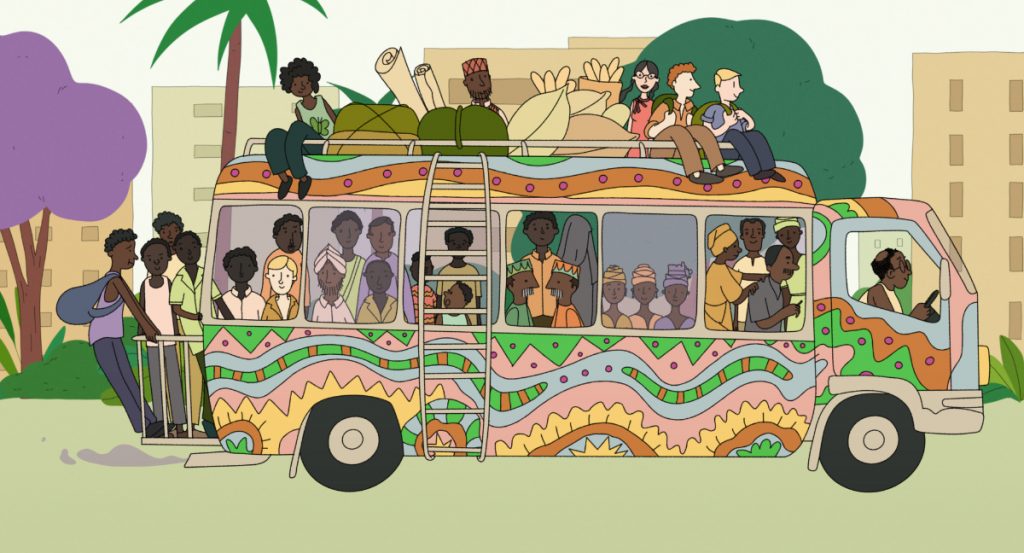
I saw you mention in another interview that this film’s production was different from previous productions because you had a relatively short production schedule. How did you find the experience of a shorter production schedule?
Torill: As I mentioned, the script period of the film was extended because of the pandemic. The storyboard and animatic phase was long, too. Some of this had to do with waiting for financing, some of it was because it was a challenging story to base a film on. So when we got greenlit, I didn’t want the production to take another two years. The film would be the longest I’ve made, and I knew I couldn’t do it alone. I wanted a more extensive team because I didn’t want the project to take so long that we’d lose all that energy and enthusiasm that builds during the animatic process.
We built a great team of animators. After the pandemic, it was challenging to find animators in Montreal and many were only available for short periods or only part-time. So the credits make it look like we had a vast team, but it was just many spread out over one year. I animated a little myself, but I primarily directed the animators. I loved working with so many people, but at the same time, I found directing animation challenging. And I haven’t honed my animation skills enough to feel confident directing others; my animation style is very intuitive and hard to explain. So it was a steep learning curve for me to figure out how to explain to others how I envisioned movement and timing. Sometimes, the best I could do was show scenes from my other films.
All things considered, the faster production time went well. We didn’t have many hiccups. I learned a lot from the animators, and I loved having a layout artist. The clean-up, compositing, and colourist teams were terrific as well. I liked having a production team for efficiency but also for the company in the creative process. It was not lonely!
You both narrate and voice-act in Maybe Elephants. Was this your first time doing so? How did you find the experience?
Torill: It’s all Storyboard Pro’s fault! That’s how I made my animatic. Every day I would just sit with my microphone and record straight into the storyboard. I got used to hearing myself talk, and it was kind of fun to tweak the writing that way. When the animatic was finished, I and everyone had gotten used to my voice so it didn’t seem necessary to find someone else to do it.
So, I ended up narrating and being the middle child’s voice. We had a voice coach who came in and coached everybody, and I learned so much by just watching him. It was inspiring to learn something about how to communicate with and direct actors. It was also convenient that I was a voice actor because it made any retakes we wanted for the narration much easier. So, yes, I really enjoyed doing the voices, and it worked well for this film. I’m not sure I’ll do it again, though!
Your film explores memory, and how our memories can reframe past events. Throughout the film, it becomes clear that the way the narrator remembers things may be a mechanism for making sense of her life, and that of her mother. Why was it important to you to explore memory in this film?
Torill: I think it’s interesting how memory isn’t that reliable over time. I’m fascinated by how my siblings remember things differently or remember things I don’t remember at all. When I look at my family history and life and try to make sense of it, I take advantage of the fact that I don’t remember things exactly, so I can make things up.
I would like to think of my mother as a certain kind of woman because it helps me feel at peace about who she was. It makes me feel good to think of her as someone who was doing her best, who was brave and courageous, and who was concerned about the well-being of people outside her family. I like to remember her as an idealist and a feminist.
If I used cold, hard facts, I might come up with a conclusion I like less. Maybe I would think of her as someone who was a little more selfish or out of tune with her children. I think people do it all the time, the rose-coloured glasses thing. I wanted to reframe it and find a way to be at peace with it.
So I had already reached these conclusions about my mother and how we reframe our perceptions of people using memory before making the film. However, the film still contains vulnerability, and I sometimes feel vulnerable when discussing it.
Watching it with others can be difficult for me, and sometimes I prefer not to be in the audience. One thing I didn’t think so much about while making it was the scene where the sisters walk away from each other. It’s part of the film that represents a sadness that I didn’t realize was there, a sadness around how my sisters and I separated for a while back then. I’ve thought more about that since I made the film.
Maybe Elephants is definitely a personal film, but I’m hoping it’s universal enough for people to connect to it. Most people can relate to the idea that our memories and perceptions of a person or an event change over time.
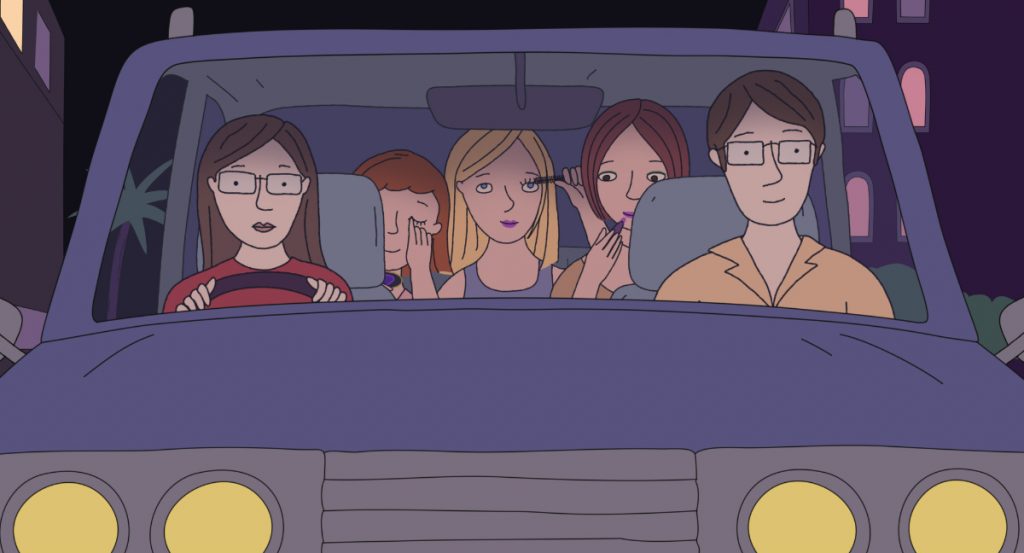
How do you think film, particularly animation, is a useful or conducive medium for autobiographical stories? Is there a reason you’ve used the medium multiple times to tell your own autobiographical stories?
Torill: I am sure there are learned theories about why this is the case, but I think it has something to do with animation being a very forgiving medium. It’s also an art form with a very rich cinematic language, giving you many tools to express yourself.
I know you used Storyboard Pro and Harmony for Maybe Elephants, as well as for other productions. What do you think of the software?
Torill: I really enjoy using Toon Boom’s software. The interface is so manageable. And over the years I’ve spent using it, it’s been rare that something goes wrong. And when something does, it’s so easy to get help. Toon Boom has an excellent support team and tons of helpful resources. Software like Storyboard Pro and Harmony has made it so simple for people to get into animation and to make their own films. It’s really impressive how much an artist can do on their own these days. I think if there are people out there interested in getting started on their own film, the first step is to simply start creating.
What is next for the film? When and where can audiences see Maybe Elephants?
Torill: So far, Maybe Elephants has had a pretty busy life in the international festival circuit. I hope it gets to travel some more and meet some more audiences. Then, eventually, it will be available on NFB’s website and other screening platforms.
- Interested in viewing Maybe Elephants? The short is currently screening in competition at festivals worldwide, and in the meantime you can add it to your list on the NFB’s website.
- Want to see more from the filmmaker? You can follow Torill Kove on Instagram at @torillkove.
- Do you want to record voiceover on the animatics for your next animated short? Artists can download a 21-day trial of Storyboard Pro.


